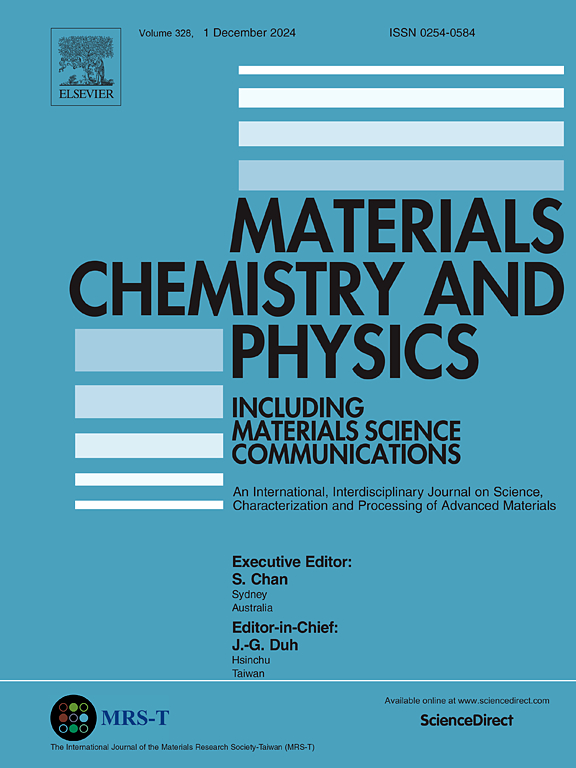Construction and characterization of 5,6-O-Isopropylidene-L-Ascorbic acid-loaded silver and manganese dioxide nanoparticles: Cytotoxicity study, antibacterial, and antioxidant activities
IF 4.3
3区 材料科学
Q2 MATERIALS SCIENCE, MULTIDISCIPLINARY
引用次数: 0
Abstract
Nanomaterials are increasingly recognized for their potential in biomedical applications due to their unique properties. This study introduces a novel approach to synthesizing and characterizing multifunctional silver (Ag) and manganese dioxide (MnO₂) nanoparticles (NPs) coated with 5,6-O-Isopropylidene-l-Ascorbic Acid (IAA), a vitamin C derivative. The primary objective was to evaluate their potential for antibacterial, antioxidant, antibiofilm, and anticancer applications. The nanocomposites were synthesized using chemical methods and characterized using FTIR, 1H NMR, Mass spectroscopy, UV–vis, XRD, SEM, and TEM. Results demonstrated enhanced antibacterial activity, with inhibition zones ranging from 30 to 40 mm for Ag NPs-IAA and 14–33 mm for MnO₂ NPs-IAA. The minimum inhibitory concentrations (MIC) were 4–32 μg/mL and 16–64 μg/mL for Ag NPs-IAA and MnO₂ NPs-IAA, respectively. Antibiofilm activity reached 89 % for Ag NPs-IAA and 82 % for MnO₂ NPs-IAA. Antioxidant activity, assessed via DPPH scavenging, showed significant enhancement upon IAA loading, achieving 86.31 % for Ag NPs-IAA and 81.35 % for MnO₂ NPs-IAA. Cytotoxicity studies against MCF-7 and PC-3 cell lines revealed that the nanocomposites inhibited cell proliferation and induced apoptosis. These findings highlight the significant potential of IAA-encapsulated Ag NPs and MnO₂ NPs in antibacterial, antibiofilm, antioxidant, and anticancer therapies, paving the way for advanced therapeutic nanomaterials.
纳米材料因其独特的性能,在生物医学应用中的潜力日益得到认可。本研究介绍了一种合成和表征涂有 5,6-O-Isopropylidene-l-Ascorbic Acid(IAA)(一种维生素 C 衍生物)的多功能银(Ag)和二氧化锰(MnO₂)纳米粒子(NPs)的新方法。主要目的是评估它们在抗菌、抗氧化、抗生物膜和抗癌方面的应用潜力。纳米复合材料采用化学方法合成,并使用傅立叶变换红外光谱、1H NMR、质谱、紫外可见光、XRD、扫描电镜和 TEM 进行表征。结果表明,Ag NPs-IAA 和 MnO₂ NPs-IAA 的抑菌区分别为 30 至 40 毫米和 14 至 33 毫米。Ag NPs-IAA 和 MnO₂ NPs-IAA 的最小抑菌浓度(MIC)分别为 4-32 μg/mL 和 16-64 μg/mL。Ag NPs-IAA 和 MnO₂ NPs-IAA 的抗生物膜活性分别达到 89% 和 82%。通过 DPPH 清除率评估的抗氧化活性显示,添加 IAA 后抗氧化活性显著增强,Ag NPs-IAA 的抗氧化活性达到 86.31%,MnO₂ NPs-IAA 的抗氧化活性达到 81.35%。针对 MCF-7 和 PC-3 细胞系的细胞毒性研究表明,纳米复合材料可抑制细胞增殖并诱导细胞凋亡。这些研究结果突显了IAA封装的银纳米粒子和MnO₂纳米粒子在抗菌、抗生物膜、抗氧化和抗癌疗法方面的巨大潜力,为先进的治疗纳米材料铺平了道路。
本文章由计算机程序翻译,如有差异,请以英文原文为准。
求助全文
约1分钟内获得全文
求助全文
来源期刊

Materials Chemistry and Physics
工程技术-材料科学:综合
CiteScore
8.70
自引率
4.30%
发文量
1515
审稿时长
69 days
期刊介绍:
Materials Chemistry and Physics is devoted to short communications, full-length research papers and feature articles on interrelationships among structure, properties, processing and performance of materials. The Editors welcome manuscripts on thin films, surface and interface science, materials degradation and reliability, metallurgy, semiconductors and optoelectronic materials, fine ceramics, magnetics, superconductors, specialty polymers, nano-materials and composite materials.
 求助内容:
求助内容: 应助结果提醒方式:
应助结果提醒方式:


